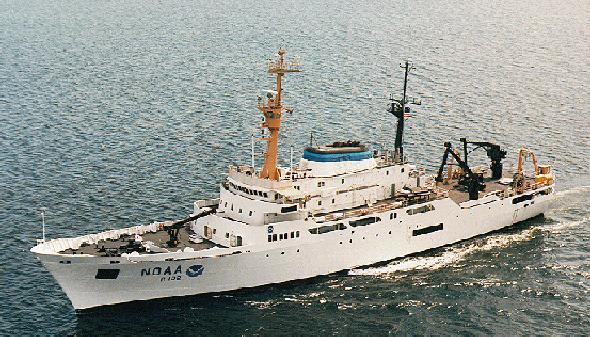


| The NOAA Ship DISCOVERER was decommissioned on August 16, 1996, and is no longer in service. |
The ocean research vessel DISCOVERER is 303 feet long and is the largest ship in the NOAA fleet. DISCOVERER proudly carries forward the name of an earlier U.S. Coast and Geodetic Survey ship DISCOVERER (1919-1941) formerly engaged in surveys of the Pacific Ocean waters, particularly the Alaskan area. The ship is operated by the Office of NOAA Corps Operations and commanded by officers of the NOAA Corps. DISCOVERER offers scientists and observers a unique opportunity to learn about and work in remote regions of the Pacific Ocean. Homeported in Seattle, Washington, DISCOVERER spends 240-270 days of the year at sea, involved in research efforts designed to improve man's understanding and use of his environment. The ship's base schedule is planned around standardized projects, but piggyback and ancillary activities can nearly always be accommodated on a space available basis.
 The mission of DISCOVERER is to provide the means for the collection of oceanographic and meteorological data at sea. Primary research is conducted by scientist from NOAA's own labs, college and university campuses, private research institutions, and other government agencies.
The mission of DISCOVERER is to provide the means for the collection of oceanographic and meteorological data at sea. Primary research is conducted by scientist from NOAA's own labs, college and university campuses, private research institutions, and other government agencies.
DISCOVERER's size and construction allow global research capabilities. Nominal maximum cruising range, at a standard speed of 16 knots, is 13 thousand nautical miles. The ship can be provisioned for five months at sea, and her fresh water evaporators provide a continuous supply of fresh water.
The hull is of welded steel construction with structural reinforcing for operation in floe ice. DISCOVERER is capable of operating in conditions up to Beaufort scale 8 (fresh gale) conditions, with winds 34-40 knots and average waves to 18 feet.
DISCOVERER's assigned projects vary from cruise to cruise. It is also common for several different projects to be carried out simultaneously. The types of studies carried out are varied and may include biological, chemical, geological and physical oceanography, meteorological and/or seismic research.
Detailed information is available by clicking on the following subjects:
Last Update November 1, 1996
Direct inquiries and comments to: Ken.Long@noaa.gov
URL: http://www.pmc.noaa.gov/di/index.htm